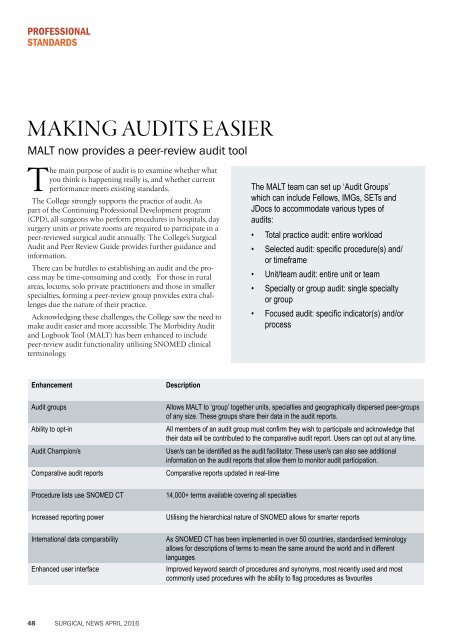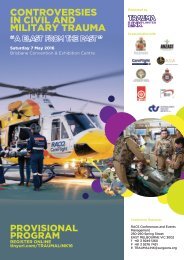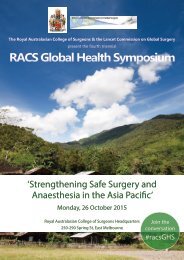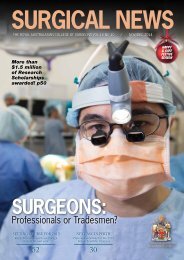Create successful ePaper yourself
Turn your PDF publications into a flip-book with our unique Google optimized e-Paper software.
PROFESSIONAL<br />
STANDARDS<br />
PROFESSIONAL<br />
STANDARDS<br />
MAKING AUDITS EASIER<br />
MALT now provides a peer-review audit tool<br />
The main purpose of audit is to examine whether what<br />
you think is happening really is, and whether current<br />
performance meets existing standards.<br />
The College strongly supports the practice of audit. As<br />
part of the Continuing Professional Development program<br />
(CPD), all surgeons who perform procedures in hospitals, day<br />
surgery units or private rooms are required to participate in a<br />
peer-reviewed surgical audit annually. The College’s Surgical<br />
Audit and Peer Review Guide provides further guidance and<br />
information.<br />
There can be hurdles to establishing an audit and the process<br />
may be time-consuming and costly. For those in rural<br />
areas, locums, solo private practitioners and those in smaller<br />
specialties, forming a peer-review group provides extra challenges<br />
due the nature of their practice.<br />
Acknowledging these challenges, the College saw the need to<br />
make audit easier and more accessible. The Morbidity Audit<br />
and Logbook Tool (MALT) has been enhanced to include<br />
peer-review audit functionality utilising SNOMED clinical<br />
terminology.<br />
The MALT team can set up ‘Audit Groups’<br />
which can include Fellows, IMGs, SETs and<br />
JDocs to accommodate various types of<br />
audits:<br />
• Total practice audit: entire workload<br />
• Selected audit: specific procedure(s) and/<br />
or timeframe<br />
• Unit/team audit: entire unit or team<br />
• Specialty or group audit: single specialty<br />
or group<br />
• Focused audit: specific indicator(s) and/or<br />
process<br />
MALT now offers a suite of comparative audit reports. These<br />
reports compare individuals to the aggregate of the audit<br />
group. These reports can then be discussed as a peer-group.<br />
The surgical outcome reports provide comparison of results<br />
against the aggregate for:<br />
• Complications<br />
• Death<br />
• Return to theatre<br />
• Unplanned Readmission<br />
• Unplanned ICU admission<br />
The data in the reports can be filtered based on various risk<br />
factors.<br />
The new functionality was successfully piloted during 2015<br />
at the Royal Darwin and Mount Gambier Hospitals. Dr John<br />
Treacy, FRACS, Supervisor and Audit Coordinator for the<br />
Department of Surgery at the Royal Darwin Hospital has<br />
been an active supporter of MALT and took on the role of<br />
audit champion for the duration of the pilot.<br />
All pilot participants were given the opportunity to provide<br />
feedback with the majority being positive. Some specific<br />
comments included: “It is straightforward to enter data”,<br />
“The reports are great – very easy to achieve what I set out<br />
to do” and “The actual data is great, what we have wanted to<br />
see for a long time”.<br />
Supported and maintained by the College, the MALT<br />
system can now make the audit process easier. If you are<br />
interested in using MALT as a peer review tool for an audit,<br />
please complete the MALT Peer Review Audit Expression<br />
of Interest Form. This form and additional MALT related<br />
audit information is available from the MALT peer-review<br />
webpage at www.surgeons.org/maltpeerreview<br />
Enhancement<br />
Description<br />
Audit groups<br />
Ability to opt-in<br />
Audit Champion/s<br />
Comparative audit reports<br />
Allows MALT to ‘group’ together units, specialties and geographically dispersed peer-groups<br />
of any size. These groups share their data in the audit reports.<br />
All members of an audit group must confirm they wish to participate and acknowledge that<br />
their data will be contributed to the comparative audit report. Users can opt out at any time.<br />
User/s can be identified as the audit facilitator. These user/s can also see additional<br />
information on the audit reports that allow them to monitor audit participation.<br />
Comparative reports updated in real-time<br />
Procedure lists use SNOMED CT<br />
14,000+ terms available covering all specialties<br />
Increased reporting power<br />
International data comparability<br />
Enhanced user interface<br />
Utilising the hierarchical nature of SNOMED allows for smarter reports<br />
As SNOMED CT has been implemented in over 50 countries, standardised terminology<br />
allows for descriptions of terms to mean the same around the world and in different<br />
languages<br />
Improved keyword search of procedures and synonyms, most recently used and most<br />
commonly used procedures with the ability to flag procedures as favourites<br />
Sample of Funnel Plot Report - Return to theatre rate<br />
More information:<br />
Karen Walton, Senior Project Officer Email: karen.walton@surgeons.org Phone: +61 8 8219 0915<br />
Kylie Harper, Project Officer kylie.harper@surgeons.org Phone: +61 8 8219 0970<br />
48 <strong>SURGICAL</strong> <strong>NEWS</strong> APRIL 2016 <strong>SURGICAL</strong> <strong>NEWS</strong> APRIL 2016 49






